When it comes to the entrance of spirits onto a scene, the main rule is this (as we all know): The exceptionally good ("holy") and powerful spirits come from above and the exceptionally bad (as in "they are coming from Hell") and powerful ones come from below -- while ghosts of ordinary dead people enter at ground level (unless they're raised from their grave six feet below the surface - but then they end up at ground level or just barely above).
Another "rule" seems to be that these visitors usually enter the scene to the left (i.e., the viewer's left) of the person or persons they've come to interact with. Of course there are exceptions, but it does seem that most of them enter from the left, especially if it's their idea (or the idea of their superior, who has given them orders) to make this contact with one or more living humans (and sometimes animals); on the other hand, it seems that in most cases if someone summons a spirit then the summoner is shown to the left of the spirit.
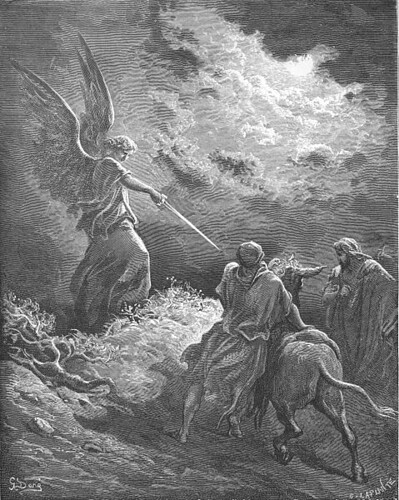
An Angel Appears to Balaam - 1866
Artist: Gustave Doré (1832–1883)
From Wikimedia, this picture is in the public domain
The angel, who at this point can only be seen by the donkey, has obviously entered the scene from the left (i.e., the viewer's left), and obviously from above, as we can see that she has wings of a size that would be awkward for regular use at ground level but very useful for flying purposes, plus of course it is common knowledge that angels live in Heaven (which is "above").
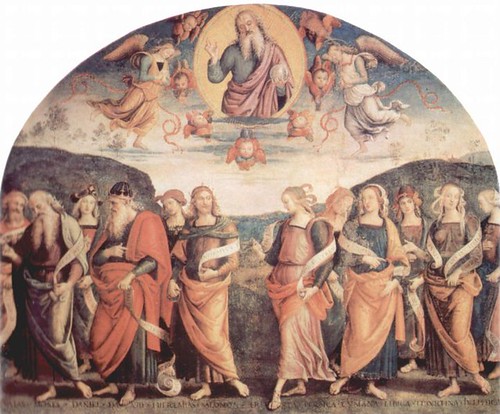
Artist: Pietro Perugino (1446-1524)
When God himself decides to communicate with people on earth, things are a little different. In pictures he very often seems to reveal himself from directly above - or very close to it - and doesn't come anywhere near ground level. He is often in something resembling a bubble, or large halo (aureola) when he is in this location. In addition to announcing his "holiness," these appear to seal him off from everything outside them. This appearance by God does not have to do with approaching humans at their level. This is not a "visit" so much as "vision," or some kind of a revelation, and is a one-way communication, apparently without any expectation of, nor desire for, immediate personal response from the human(s) below. The fact that he is near the top of the picture also makes it clear that this is a picture that is meant to imply a hierarchy wherein the person "on top" has power over those below even though they may not come into direct contact with them.*
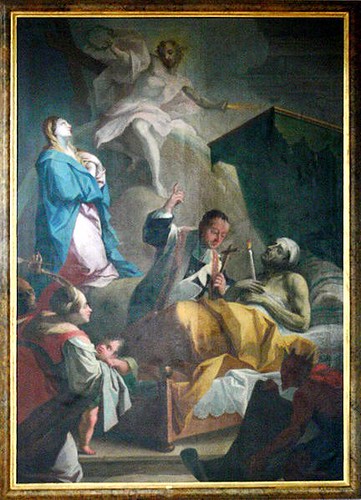
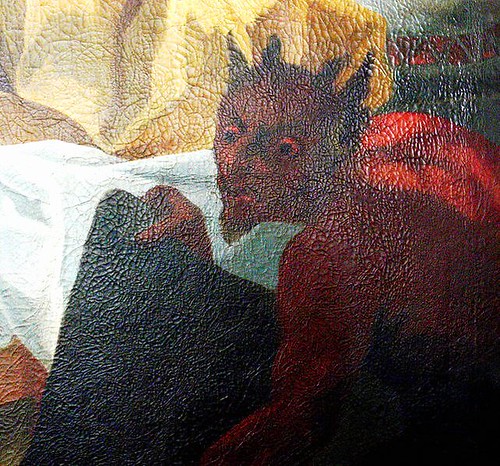
I don't know the story behind the deathbed scene above, but this picture seems to me to be extremely easy to read, with its zigzag composition that includes all the characters, who are arranged in a way that tells us much more quickly than words what is going on here -- Without knowing anything about this, not even the title, it appears obvious to me that: the man is dying and receiving the last sacraments from a priest who is no doubt at that very moment pleading with Mary to intervene and ask that this man's soul be accepted in Heaven. Mary is placed between God (who is above, and not personally participating in the deathbed event) and earthly life, and she is (looking at and) begging God to have mercy on this man and either to let him live...because, as it also very obvious, the man has a wife and baby who will be left behind if he dies...or to let him into Heaven. Meanwhile the devil, rising from blackness below, and unseen by all, is surveying the whole scene and apparently waiting to take the man's soul down with him to Hell. The scene is pertinent to this essay because of the visitations of Mary (from above left) and the Devil (from below right) as well as the appearance of God to Mary, who has summoned him in order to make a request.
As mentioned earlier, whether the living person is purposely approaching or summoning the spirit, or the spirit is approaching the living human of his or her own volition, sometimes seems to make a difference with regard to which side of the picture they seem to have entered from. I have noticed that it is usually the one who has the idea of communicating who is at the (our) left. In the above picture the summoner is the priest on behalf of the man. The devil has taken it upon himself to enter the scene -- he was not summoned by anyone.
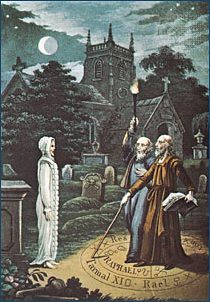
The image is based on an 1806 illustration by Ebenezer Sibly.
In the above picture, the idea of communicating was that of the magician, not the ghost, yet the ghost is shown to our left. But if you look at the illustration this picture was based on, below, you will see that the artist, Ebenezer Sibly, shows the magician and his friend on the left and the ghost on the right.
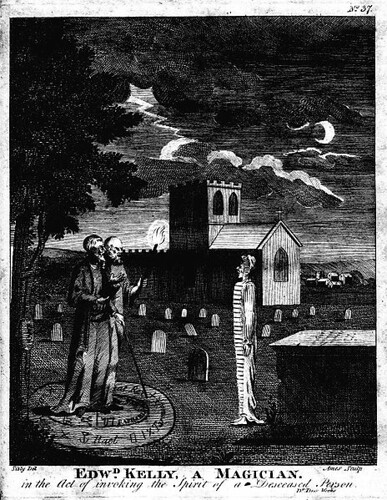
Engraved by Ames of Bristol (1806), original drawing by Ebenezer Sibly
Ghost of humans who, upon death, did not graduate to Heaven nor plunge directly into the depths of Hell (they seem to still be entirely preoccupied with earthly affairs and want to be handy so they can interfere in them easily), may approach people from any direction (except from skies above or from below, with the exception of rising from their own grave or from a lower floor or basement), but generally they approach at ground level or at times floating, upright, just a tad above the ground (no doubt due to their weightlessness - It's hard to keep your feet on the ground when you're a ghost, apparently).

Artist: Howard Pyle (1853 - 1911)
"The Witch of Endor, sometimes called the Medium of Endor, was a woman who called up the ghost of the recently deceased prophet Samuel, at the demand of King Saul of the Kingdom of Israel in the First Book of Samuel, chapter 28:3–25."
I am not sure which of these figures is the witch, but I'm assuming it's the person on the (our) right side of the picture, dressed in blue. "Her" arm is raised as if to "pull up" the spirit (yet the spirit seems to only have eyes for the fellow in orange, who must be King Saul, though I don't know). All I know about this story is what is quoted in the above paragraph, but the story the picture tells is what concerns me. We should be able to get the general idea of what's going on without knowing the story ahead of time.
The witch seems to have pulled up Samuel directly out of his grave. The relationship between the three, if we are to go by their positions in the picture seems to be that it is the man on the left who is the one who summoned the spirit, using the witch to do so, and that would fit the short description quoted in the last paragraph. In other words, the entity whose idea it was to make contact is to the left (i.e., our left) of the ghost (which tells us why the ghost is facing in that direction).
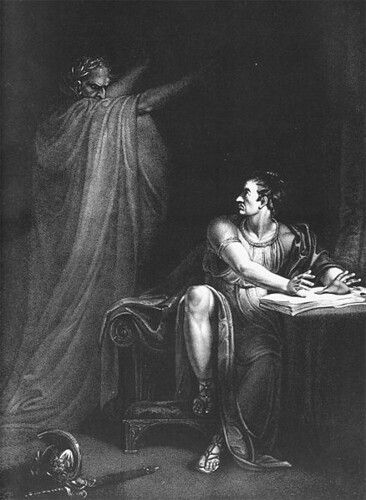
Brutus, visited by the ghost of Julius Caesar, whom he has helped to kill, is obviously feeling very worried here. The ghost is probably no taller than Brutus would be if he were standing, but still he seems quite threatening not only because of his gesture and his evil look, but because he (particularly his head - the center of his thoughts, which lead to actions) occupies quite a large area near the top of the picture and "above" Brutus who has been sitting in a casual fashion, not ready to run anywhere. Also, Brutus has been surprised from behind by the ghost and being penned in by the table (and apparently a wall or a drape to his left) is not prepared for a quick exit whether he can get his feet under him or not.
Above: The description under this picture says that this man's murdered wife (the ghost) has just handed her baby to her husband, and that the woman's spirit lives in the rock that her blood flows from.
I don't know whether the man went to the rock to implore his dead wife to give him the baby, or if he was just there to visit her spirit as one normally visits a grave of a departed loved one and it was her idea to hand over the baby, or if perhaps he has just killed her himself, though I doubt the latter as it does say her spirit "lives" in the rock as if has been living there for some time.
She is looking toward her husband but there is some reason she has turned her back on him after handing him the infant. Perhaps he killed her some time earlier, and giving him the baby was her revenge - though if he had killed her, certainly he wouldn't want to visit the place where she was murdered as he'd probably be very worried about what her ghost might do to him.
The fact that she is "above" him in the picture, in the same area that Ceasar inhabits in the picture above, may tell us that she is the one whose idea it was to appear to her husband...that it was not his idea. I really don't know. I am not (at this time) able to "read" this picture clearly. Possibly if I had been raised in the Japanese culture it would be obvious.
Artist: William Blake
When I first saw this picture I thought it was unfinished. Then I realized, or supposed, that it was not, that we finish it in our own minds, not with any "thing" that could be seen, but with a huge feeling of dread of the unknown.
Whatever it is, this "doom" that is approaching is coming from the left and it is filling the air over and under and around the people, nibbling away at them - dissolving them. They are backed up at the right as if they had gone in that direction to escape, but now have nowhere else to go as they have reached a dead end. Their legs are straight and their arms are entwined so they can be as close together and as far away from the dreadful thing as possible, and they are looking the only way there is to look, directly into whatever it is, which they can't see clearly but know means their certain death.
No monster could look as frightening as this cloud of "nothingness" that is enveloping them and that there is no escape from. The white tentacle-like shape at upper left that seems to be leaping toward the huddled group makes us realize that this is no innocent fog but something that contains a hellish element that seems to be throwing its light onto them, seeking them out in order to find and destroy them, very likely by dissolving them so that they become part of the cloud.
You may think I'm reading too much into this because I know the name of the picture ("The Approach of Doom"), but try to imagine this picture with a less morbid name, such as "A Lovely Summer Night's Walk in the Cooling Fog." You would probably then look at the picture and say to yourself: "I don't think so."
My hope is that this little essay will help the reader to realize that the placement of objects in pictures, in relation to each other and in relation to the perimeter of the picture, is very important to the viewer's understanding of what the picture is about.
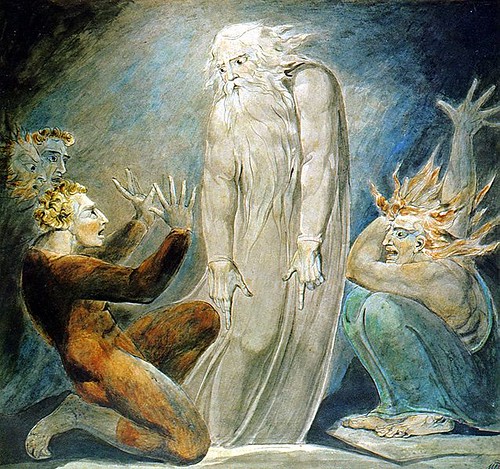
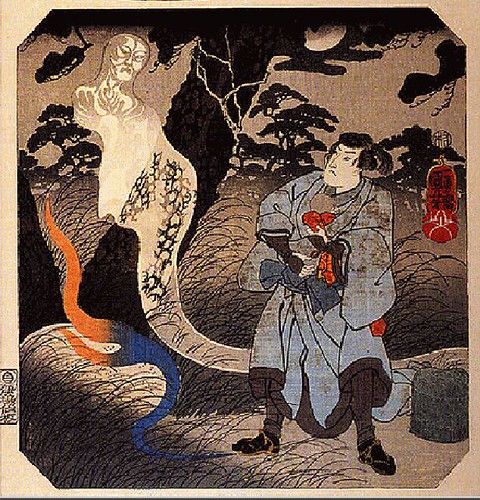
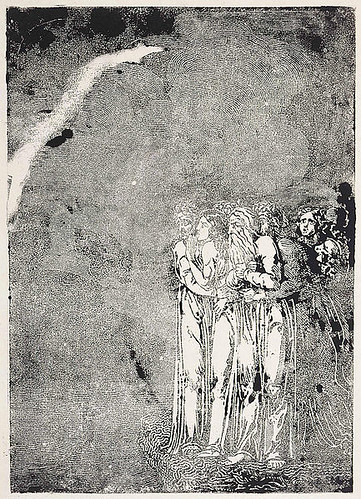

2 comments:
Very interesting, Jean, that the placement of objects seems so ingrained into our collective psyche - even with the example of Japanese art you provided here. Certainly, God (or the Gods) being above and Satan below seems very intuitive. The examples you've provided, though, with the more "everyday" types of spirits were fascinating for the consistent patterns that emerge. Examples in Japanese art would be interesting to look further at since the formal approach to visual content is somewhat different than with western works. The usual example of this of course is that text in Japanese is usually read from the right side of the page to the left (that is, when it's formatted in the traditional vertical manner of right-to-left, top-to-bottom - in modern writing such as in email messages it's often left-to-right and top-to-bottom, although books are still usually formatted traditionally)
Brian, I added the Japanese picture not to illustrate the tendency to place the "person whose idea it was for the appearance" at the left, but to show that in a different culture the reading of the picture might be somewhat different. In the Japanese culture (at least "of old") as I understand it, a picture is seen "overall" at first glance, the viewer not looking immediately for a focal point that they can identify with so they can understand what they're seeing, as we in the Western culture do. In my posts I am almost always referring to pictures produced by our Western culture (western Europe and the U.S., mainly) over several centuries. I am aware that in some cultures people read down a page or even back and forth, etc., rather than from left to right as we do, and this has an influence on how we "read" what is happening (or what we are to understand) in a picture. However, there is something we have in common with people in all cultures that affects how we read a picture, no matter in which direction(s) we have learned to read and write. That has to do with the brain. I will be writing about this in the future. As for gods above and devils below being intuitive, I will be writing more about the probable reasons for that, also, though I have (perhaps too lightly) touched on it in at least one previous post. I can never write more than a small part of what I would like to write in each post, planning to write more later. Thank you for your comments! It's helpful to me to have comments because I know what I need to emphasize in future posts, and your particular comments are especially thoughtful and very much appreciated. - Jean
Post a Comment